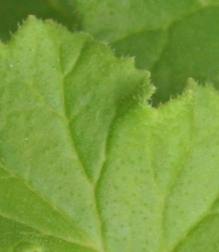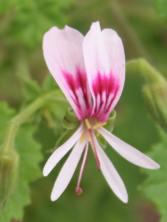Pelargonium greytonense
Pelargonium greytonense J.J.A.v.d.Walt
Family: Geraniaceae
Common names: Greyton pelargonium
Introduction
This is a fairly small, fragrant pelargonium for the scented garden.

Description
Description
Pelargonium greytonense is an erect, much branched 1 m shrub 0.75 m in diameter. The stems are soft and green when young but become woody when older. Minute hairs with a few scattered long soft hairs, as well as glandular hairs which are green but become greyish brown when older, are present on the stem.
The palmately (hand-like ) incised leaves are covered with short and rather stiff as well as scattered long hairs. The leaves are aromatic.

Flowers are white to pale pink and are borne in umbel-like inflorescences. This species flowers between September and January with a peak flowering period in October and November.

Conservation Status
Status
Pelargonium greytonense is listed on the Red List of South African plants (Raimondo et al . 2009) as Rare.
Distribution and habitat
Distribution description
Pelargonium greytonense has a small distribution area in the southwestern Western Cape on the southern slopes of the Riviersonderend Mountains. This area receives rain primarily during the winter months and is frost-free because it is relatively close to the coast. High temperatures are experienced during the summer months. Although this species grows only in a small area it occurs locally in large numbers. It is mainly found growing in ravines.
Derivation of name and historical aspects
History
The Irish botanist William Henry Harvey divided the genus Pelargonium into 15 sections. The distinctive features of the different sections are mainly leaf and flower characteristics and habitat. Pelargonium greytonense is classified under the section Pelargonium. This section consists of profusely branched often woody shrubs. Their leaves are rarely entire but usually recurrently lobed or divided. The upper two petals are broader and longer than the lower three petals. Seven fertile stamens are present. Other species belonging to this section are P. betulinum, P. capitatum, P. cucculatum and P. papilionaceum. People often refer to pelargoniums as geraniums.
Pelargonium greytonense belongs in the family Geraniaceae, a large cosmopolitan family of approximately 11 genera and 800 species in subtropical and temperate regions of the world. The South African genera in the Geraniaceae family are Monsonia , Sarcocaulon , Pelargonium , Erodium and Geranium . There are approximately 270 species of Pelargonium which occur in S, E and NE Africa, Asia, St Helena, Tristan da Cunha, Madagascar, Australia and New Zealand, but mostly (± 219 species) in southern Africa. Pelargonium gets its name from the resemblance of the fruit to the beak of a stork, which is pelargos in Greek. The specific name greytonense refers to the town of Greyton where the species is found.
Ecology
Ecology
The seed is adapted to wind dispersal; it is light in weight and has a feathered, spiral tail. When the seed lands and there is sufficient moisture in the soil, the tail becomes like a drill, twisting the seed into the soil so that the seed can anchor itself in the ground and prevent itself from being blown away, or carried away by moving animals. This ensures that most of the seeds produced, five seeds per flower, have a good chance of germinating.
Uses
Use
There are no recorded cultural uses for Pelargonium greytonense. The leaves have a sweet aromatic scent, making this plant an excellent addition to any scented garden. This species will do well in containers and smaller areas in the garden. It is well suited to grow among other smaller herbaceous perennials.
Growing Pelargonium greytonense
Grow
Pelargoniums are found growing in most areas of South Africa in a wide range of habitats. It is impossible to lay down one set of growing requirements to suit all species. The most important consideration is to note the natural habitat and the conditions the species grows in and then to attempt to copy these natural conditions as closely as possible. Pelargoniums are easily grown, fairly adaptable plants and are most rewarding in any garden. Pelargonium cultivars have been gracing the balconies of buildings and gardens in the northern hemisphere for many years and have been rated as excellent garden plants.
Pelargonium greytonense, like most other members of the genus, is easily grown from either seeds or cuttings. Cuttings are propagated at any time of the year but best after flowering and seeding. Take semi-mature stem cuttings 150 mm long and apply a rooting powder to stimulate rooting. Place the cuttings into a propagation tray with individual cavities. The cuttings are then placed in a cold-frame or a cool well lit area to root. The cuttings will root within 3 weeks. Once the cuttings have rooted, pot into a well-drained potting soil. The soil medium is made up of equal parts compost, coarse riversand and loam. Young plants can be fed on a monthly basis with an organic-based liquid or granular fertilizer.
This Pelargonium is a winter-rainfall species. Seeds are sown in autumn. Sow the seeds in a light, well-drained potting soil mixture. Broadcast the seeds evenly in the seed tray and cover them with a layer of clean white sand or fine-milled pine bark. The depth of sowing is usually one-and-a-half times the size of the seed. Water thoroughly but gently and provide light shade. Germination usually takes place within 4 weeks. Seeds are best sown when fresh although they may remain viable for up to seven years. Pelargoniums grown from seed are generally more vigorous than those derived from cuttings. They do, however, tend to take longer to produce flowers. Plants grown from seed will show some degree of variation, and if a particular form or variant is required it must be propagated by cuttings.
References
- Powrie, F., 1998. Grow South African plants . Kirstenbosch Gardening Series. National Botanical Institute, Cape Town.
- Raimondo, D., Von Staden, L., Foden, W., Victor, J.E., Helme, N.A., Turner, R.C., Kamundi, D.A. & Manyama, P.A. (eds). 2009. Red List of South African plants 2009. Strelitzia 25. South African National Biodiversity Institute, Pretoria.
- Van der Walt, J.J.A. 1977. Pelargoniums of southern Africa . Purnell, Cape Town.
- Van der Walt, J.J.A. & Vorster, P.J. 1988. Pelargoniums of southern Africa , vol. 3. Kirstenbosch National Botanical Gardens, Cape Town.
Credits
Trevor Adams
Kirstenbosch Gardens
November 2012
Plant Attributes:
Plant Type: Shrub
SA Distribution: Western Cape
Soil type: Sandy
Flowering season: Spring, Early Summer
PH: Acid
Flower colour: White, Pink
Aspect: Full Sun
Gardening skill: Average
Special Features:
Horticultural zones










Rate this article
Article well written and informative
Rate this plant
Is this an interesting plant?
Login to add your Comment
Back to topNot registered yet? Click here to register.